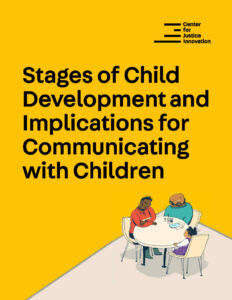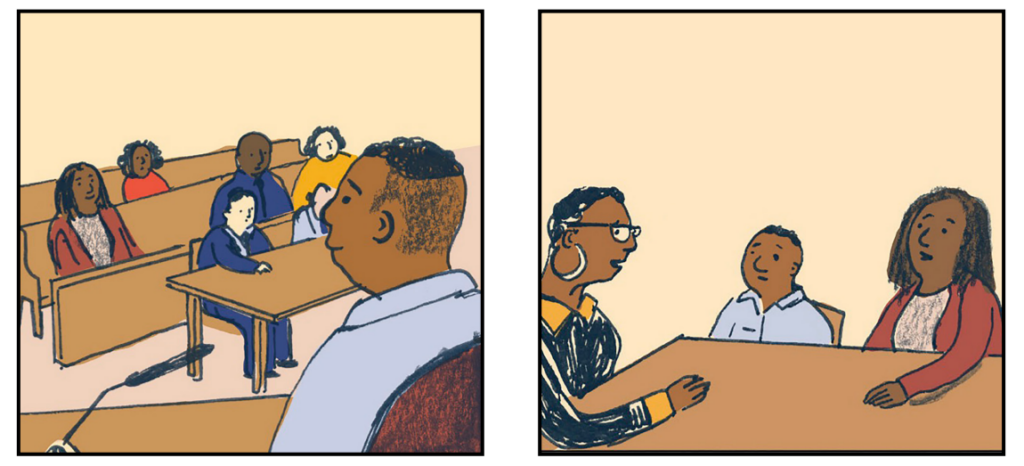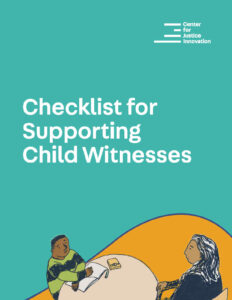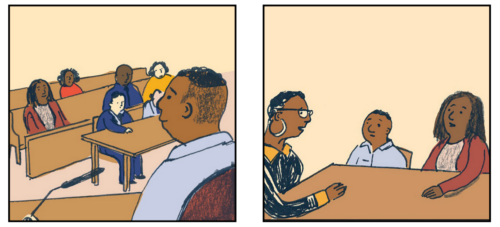With a series of interactive graphic novels, we help guide and support children navigating the legal system as victims and witnesses. An additional set of guides we worked to create ensure that practitioners have what they need to do the same.
This is the second part of a two-part series on our Child Witness Materials initiative. Read part one of the series, or access all of the materials here.
The interactive graphic novels we helped to create for child witnesses and victims responded to a crucial need: a need for culturally sensitive, developmentally appropriate, and trauma-informed materials to guide and support children navigating the legal system.

But the booklets themselves are only one piece of the puzzle—just as important is how practitioners put them to use in practice. With that in mind, our team helped to create a supplementary set of guides, with the input of practitioners from diverse professional backgrounds, for supporting children who are interacting with the legal system as crime victims or witnesses.
One guide, for example, details how children communicate at different developmental stages, offering tips for communicating effectively and supportively with children of different age groups. Another guide discusses the nature of trauma, the various ways it can manifest in children who have been exposed to violence, and how it can affect—and be exacerbated by—children’s interactions with the legal system. It also includes advice on how best to work with children who have been affected by trauma, especially as they navigate legal processes that can be confusing, difficult, and frightening.

How practitioners might actually use child witness support materials was something our team considered carefully throughout the planning stage. During needs assessments for each set of materials, the team conducted interviews and focus groups with various kinds of practitioners—from prosecutors to victim advocates to child welfare workers—who work closely with child witnesses and victims. The goal of these focus groups was to hear, first-hand, what personnel on the ground felt was most needed to support children in the legal system.
Some of the needs and challenges that practitioners identified are unique to their specific roles. Prosecutors struggle with communicating that they are not the children’s attorneys, and what their role in the legal process is. Law enforcement personnel—often the first points of contact—feel frustrated when they are unable to answer the questions that children and their caregivers have. And victim advocates struggle to prepare children for the possibility that their case does not result in the outcome they are hoping for. Other concerns cut across practitioner roles—concerns about children having to see the defendant in court, being asked to repeatedly discuss traumatic experiences, or feeling that everything is their fault.
Both the booklets themselves and the practitioner guides were created with this input in mind. One of the guides—a checklist for supporting children preparing to testify—urges practitioners to visit the courtroom with children beforehand while it’s empty, giving them the opportunity to familiarize themselves with the space and practice walking in and out. It encourages a support person to sit in the child’s line of sight throughout the proceedings. And it recommends giving children regular opportunities to talk about how they’re feeling with an advocate or therapist.

The support materials and practitioner guides have a wider significance too, as tribal and federal prosecutor Geri Wisner noted in our podcast episode about the project: “I think these materials are very good at reminding us to re-evaluate things from the perspective of a child witness or victim.” Most court procedures weren’t designed to be child-friendly—or even with children in mind. Our practitioner guides give people working in the system the chance to look at the legal process from a different perspective.
There is undoubtedly more work to be done to ensure that children and their caregivers feel supported, empowered, and prepared in their interactions with the criminal legal and child welfare systems. But our support materials and practitioner guides, created with support from the Office for Victims of Crime, are readily available to help address a number of crucial needs.
